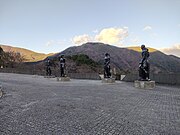Hakone Open-Air Museum
This article needs additional citations for verification. (December 2023) |
箱根 彫刻の森美術館 | |
Hakone, Japan | |
| Coordinates | 35°14′41″N 139°3′5″E / 35.24472°N 139.05139°E |
|---|---|
| Type | Art museum |
| Website | hakone-oam |
The Hakone Open-Air Museum (箱根 彫刻の森美術館, Hakone Choukoku no Mori Bijutsukan), opened in 1969, is Japan's first
Taro Okamoto, Yasuo Mizui, Churyo Sato, Susumu Shingu, Constantin Brâncuși, Barbara Hepworth, Rokuzan Ogiwara, and Kōtarō Takamura, among others.[1] About 120 sculptural works are on permanent display across the park.[2] The museum is affiliated with the Fujisankei Communications Group media conglomerate.[citation needed
]
Hakone Choukoku no Mori Bijutsukan is split into five indoor exhibitions and is best known for the Picasso Pavilion hall, containing around 300 of the Spanish artist's works. The museum also offers outdoor interactive sculptures for children and a naturally fed onsen footbath for guests.[3][unreliable source?]
Gallery
Sculpture park and gardens
-
Exterior park view
-
Joan Miró, 1972, Personnage
-
Henry Moore, 1969–70, Reclining Figure: Arched Leg
-
Exterior park view
-
Goto Ryoji, 1978, Intersecting Space Construction
-
Aristide Maillol, 1905–06, Action Enchained
References
- St. Petersburg Times. Archived from the originalon 1 May 2001. Retrieved 20 January 2010.
- ^ "About the Hakone Open-Air Museum – Hakone Travel Guide | Planetyze". Planetyze. Retrieved 15 August 2017.
- ^ "Open-Air Museum". Japan Deluxe Tours. Retrieved 21 May 2019.
External links
Wikimedia Commons has media related to Hakone Open-air Museum.






